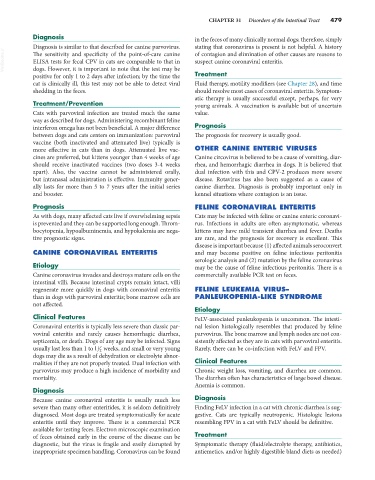Page 507 - Small Animal Internal Medicine, 6th Edition
P. 507
CHAPTER 31 Disorders of the Intestinal Tract 479
Diagnosis in the feces of many clinically normal dogs; therefore, simply
Diagnosis is similar to that described for canine parvovirus. stating that coronavirus is present is not helpful. A history
VetBooks.ir The sensitivity and specificity of the point-of-care canine of contagion and elimination of other causes are reasons to
suspect canine coronaviral enteritis.
ELISA tests for fecal CPV in cats are comparable to that in
dogs. However, it is important to note that the test may be
positive for only 1 to 2 days after infection; by the time the Treatment
cat is clinically ill, this test may not be able to detect viral Fluid therapy, motility modifiers (see Chapter 28), and time
shedding in the feces. should resolve most cases of coronaviral enteritis. Symptom-
atic therapy is usually successful except, perhaps, for very
Treatment/Prevention young animals. A vaccination is available but of uncertain
Cats with parvoviral infection are treated much the same value.
way as described for dogs. Administering recombinant feline
interferon omega has not been beneficial. A major difference Prognosis
between dogs and cats centers on immunization: parvoviral The prognosis for recovery is usually good.
vaccine (both inactivated and attenuated live) typically is
more effective in cats than in dogs. Attenuated live vac- OTHER CANINE ENTERIC VIRUSES
cines are preferred, but kittens younger than 4 weeks of age Canine circovirus is believed to be a cause of vomiting, diar-
should receive inactivated vaccines (two doses 3-4 weeks rhea, and hemorrhagic diarrhea in dogs. It is believed that
apart). Also, the vaccine cannot be administered orally, dual infection with this and CPV-2 produces more severe
but intranasal administration is effective. Immunity gener- disease. Rotavirus has also been suggested as a cause of
ally lasts for more than 5 to 7 years after the initial series canine diarrhea. Diagnosis is probably important only in
and booster. kennel situations where contagion is an issue.
Prognosis FELINE CORONAVIRAL ENTERITIS
As with dogs, many affected cats live if overwhelming sepsis Cats may be infected with feline or canine enteric coronavi-
is prevented and they can be supported long enough. Throm- rus. Infections in adults are often asymptomatic, whereas
bocytopenia, hypoalbuminemia, and hypokalemia are nega- kittens may have mild transient diarrhea and fever. Deaths
tive prognostic signs. are rare, and the prognosis for recovery is excellent. This
disease is important because (1) affected animals seroconvert
CANINE CORONAVIRAL ENTERITIS and may become positive on feline infectious peritonitis
serologic analysis and (2) mutation by the feline coronavirus
Etiology may be the cause of feline infectious peritonitis. There is a
Canine coronavirus invades and destroys mature cells on the commercially available PCR test on feces.
intestinal villi. Because intestinal crypts remain intact, villi
regenerate more quickly in dogs with coronaviral enteritis FELINE LEUKEMIA VIRUS–
than in dogs with parvoviral enteritis; bone marrow cells are PANLEUKOPENIA-LIKE SYNDROME
not affected.
Etiology
Clinical Features FeLV-associated panleukopenia is uncommon. The intesti-
Coronaviral enteritis is typically less severe than classic par- nal lesion histologically resembles that produced by feline
voviral enteritis and rarely causes hemorrhagic diarrhea, parvovirus. The bone marrow and lymph nodes are not con-
septicemia, or death. Dogs of any age may be infected. Signs sistently affected as they are in cats with parvoviral enteritis.
usually last less than 1 to 1 2 weeks, and small or very young Rarely, there can be co-infection with FeLV and FPV.
1
dogs may die as a result of dehydration or electrolyte abnor-
malities if they are not properly treated. Dual infection with Clinical Features
parvovirus may produce a high incidence of morbidity and Chronic weight loss, vomiting, and diarrhea are common.
mortality. The diarrhea often has characteristics of large bowel disease.
Anemia is common.
Diagnosis
Because canine coronaviral enteritis is usually much less Diagnosis
severe than many other enteritides, it is seldom definitively Finding FeLV infection in a cat with chronic diarrhea is sug-
diagnosed. Most dogs are treated symptomatically for acute gestive. Cats are typically neutropenic. Histologic lesions
enteritis until they improve. There is a commercial PCR resembling FPV in a cat with FeLV should be definitive.
available for testing feces. Electron microscopic examination
of feces obtained early in the course of the disease can be Treatment
diagnostic, but the virus is fragile and easily disrupted by Symptomatic therapy (fluid/electrolyte therapy, antibiotics,
inappropriate specimen handling. Coronavirus can be found antiemetics, and/or highly digestible bland diets as needed)

